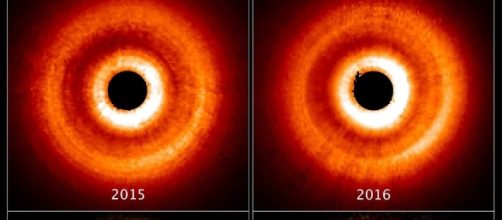Astronomers have discovered what appears to be a planet in a star system. The planet is revealing its presence by a shadow around a disk of gas and dust surrounding a young star. The planet seems to be pulling matter from the inner part of the disk surrounding the star, warping space and time in the inner part of the disk. The distorting inner disk is, in this way, casting its shadow on the outer disk’ surface. This new discovery is 178 light years away I the direction of the Constellation Hydrae (the female water snake). The planet was discovered by analyzing various observation taken during the span time of 18 years.
TW Hydra
This is a star that is approximately 0.8 solar masses and 1.1 the radius of the sun. It´s 8 million years old and has a temperature of approximately 4,000° K (6740.33° F). It is located at around 178 light years in the direction of the constellation Hydrae. This star seems to be accruing mass from a protoplanetary disk of gas and dust. The star is extremely dim to be observed from earth with an apparent magnitude of 11.7.
How they know this is a planet
Two images taken one year apart by Hubble Space Telescope show a shadow that is displacing counterclockwise around the encircling disk of gas and dust of a developing star. Astronomers believe that obscure areas of the disk belong to a planet orbiting close to the star.
It´s thought that the planet´s gravitational pull, produces a warped inner disk and that the distorted disk in turn block light from the star, casting a shade unto the outer region of the disk. Scientists have discovered that the shadow rotates around the disk once every 16 years.
Planet the size of Jupiter
Based on the relatively short orbiting of the shadow around the disk, scientists have calculated the planet to be approximately 100 million miles away from the star, or roughly the same distance the earth is from the sun. The planet is believed to be about the size of Jupiter, possessing sufficiently strong gravitational field to attract matter up from the plane of the principal disk. This new way of observation allows to search for planets inside the the disk of dust and gas of nearby stars, which opens the possibility of learning about the unseen regions of the disk.

